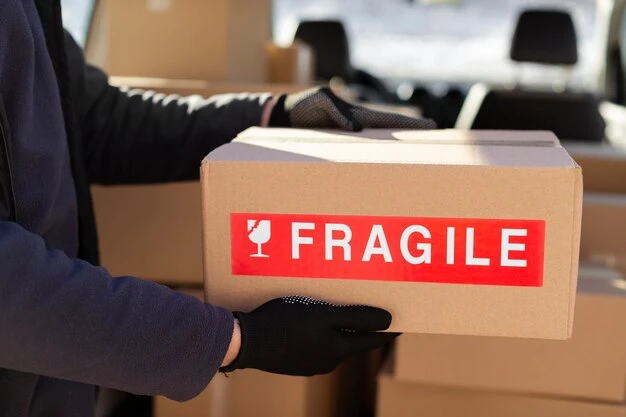Shipping delicate items can be quite a challenge for both sellers and buyers. While running an online business or shipping something fragile you must prepare yourself for uninvited accidents and losses. Sometimes it is just unavoidable no matter what carrier you choose or what promises they make.
It is not a blame game to say that the handlers do it intentionally. They are highly professional and do their job by heart daily.
It is just a moment that is unfortunate, it might be a sudden bump that a parcel just fell and damaged the product or something got hit, or while loading in the truck something more weighted damages your product.
We understand it is nerve-wracking to think about the possibility of damage occurring during transit, leading to unhappy customers, financial losses, and potentially damaging a business’s reputation. As per a search, 34% of packaging-related returns are due to damaged products received by customers.
But don’t worry, you can minimize them with careful planning, proper packaging, and following some best practices. By taking the right steps to packaging you can make sure that fragile products reach their destination in one piece.
In this guide, we’ll go through the strategies and techniques that can help you ship fragile items securely and avoid breakage.
Understanding the Nature of Fragile Products
It is important to understand what comes in the list of fragile items before learning about the complexities of shipping it. Fragile products can include a variety of items such as:
- Glassware
- Ceramics
- Electronics
- Artwork
- Delicate antiques
These items are at risk of suffering damage during shipment due to many factors, shock, vibration, pressure, and temperature changes. Identifying the unique exposures of each product is the first step towards providing their safe shipment.
Invest in Quality Packaging Materials:
It’s more cost-effective to invest in durable packaging materials than to deal with the expenses of returns, reshipments, dissatisfied customers, and negative reviews. The key to safe shipping is the quality of the packaging materials used. It is important to invest in strong boxes, cushioning materials, and protective wraps to ensure the safety of fragile items.
It is advisable to choose corrugated cardboard boxes specifically designed for shipping delicate products as they offer superior strength and durability, reducing the risk of damage during transit.
It’s important to measure the size of the box when packaging a product. A box that is too small and tightly fitted to the product may break if hit by anything. However, a box that is too large and has too much space can also cause damage to the product. A good rule of thumb is to leave approximately 2 inches of space all around the product for cushioning.
Properly Pack Fragile Items:
Follow these steps to package fragile items for transit:
- Firstly, it is important to wrap each item individually with bubble wrap or foam to provide a cushioning effect and prevent shock absorption. Make sure to pay extra attention to delicate components or bubbles that are more prone to damage.
- Once wrapped, place the items inside the box snugly, ensuring that they do not move during transit.
- Fill any empty spaces with packing peanuts, foam inserts, airbags, or crumpled paper to prevent shifting of the contents and keep them fit inside the box.
Minding the above steps will help you in packing your delicate product to prevent any damage during transit.
Label Packages as Fragile
If you think you have done your job of packaging well, we suggest you take extra precautions by using “Fragile” stickers or labels on all sides of the box so that the handlers and carriers know to exercise caution.
Also, include arrows or symbols to indicate which way the box should be introduced so that there’s less risk of mishandling. By doing these simple things, you can ensure that your package arrives at its destination without any damage.
Consider Temperature and Climate Conditions
When shipping fragile items, it’s important to keep temperature changes and effects in mind. Extreme temperatures and humidity levels can damage your products, so it’s necessary to take precautions to ensure their safety during transit. Consider using insulated packaging or thermal liners for items that are sensitive to temperature changes.
Moreover, it’s best to avoid shipping during extreme weather conditions if possible. Your products deserve the best, and we want to make sure they arrive in perfect condition.
Choose the Right Shipping Service
Many well-known companies are providing shipping services with different benefits as well. But before discussing them, let us guide you about getting shipping insurance. This is a safety measure to protect your package from loss, theft, or damage during transit, particularly for fragile items. As we discussed earlier, no matter how carefully you handle the entire shipping process, accidents can happen. Therefore, it is wise to have shipping insurance.
Now the question is which shipping company you should pick? Well, it depends on where you’re sending your package, how much it costs, and if you want to track it.
USPS
USPS used to have a special service for fragile stuff, but they don’t do that anymore. They suggest getting shipping insurance, making sure your package is packed well, and labeling it clearly.
FedEx
FedEx offers services for packing and shipping fragile items. If your package is valued at more than $100, FedEx will reimburse you for that amount if it gets lost or damaged during transit. However, if your package is very valuable, you can declare a higher value and pay extra for additional insurance coverage, up to a maximum of $1000.
UPS
UPS provides a packaging service to ensure that your breakable items are shipped safely without any extra charges. In case of any damage during shipping, UPS will reimburse you for the cost of the item, packing, and shipping.
In a Nutshell!
Fragile items are delicate and can be easily damaged during shipping. We have provided some tips to help you reduce the risk of damage to your fragile items during transit. Although it is impossible to completely eliminate the risk of breakage, implementing these tips can help minimize the likelihood of damage. We hope that this guide will be helpful in ensuring that your fragile items arrive safely at their destination.





